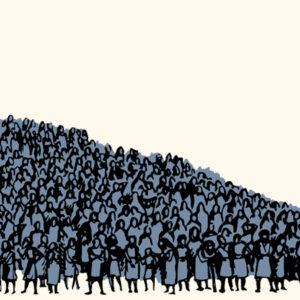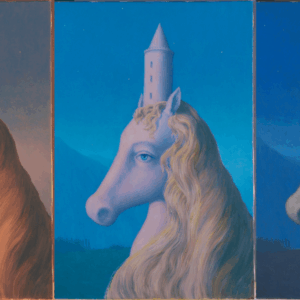
The Struggle to Define Wilderness: On Encountering John Muir in Bear Country
Bjorn Dihle: “The locals weren’t sure what to make of Muir when he confessed he had no interest in gold.”
When one is alone at night in the depths of these woods, the stillness is at once awful and sublime.
–John Muir, John of the Mountains
*Article continues after advertisement
The day John Muir encountered his first grizzly, in 1868, he had set out into the Sierra Nevada of California specifically to observe bears. He had vowed the year before to devote his life to studying nature after he’d suffered an injury, while working in a factory, that left him temporarily blinded. He wrote how he rushed two different black bears, each in order to “study his gait in running,” but both animals stood their ground, irritated by the man’s strange behavior. Later that day, Muir encountered a small grizzly and immediately fell to the ground and hid behind a clump of brush. He wrote of what transpired next:
But he had either heard my steps on the gravel or caught my scent, for he came straight toward me, stopping every rod or so to look and listen: and as I was afraid to be seen running, I crawled on my hands and knees a little way to one side and hid behind a libocedrus, hoping he would pass me unnoticed. He soon came up opposite me, and stood looking ahead, while I looked at him, peering past the bulging trunk of the tree. At last, turning his head, he caught sight of mine, stared sharply a minute or two, and then, with fine dignity, disappeared in a manzanita-covered earthquake talus.
During his first summer in the Sierra, Muir worked at a sawmill and a sheepherder—he repeatedly referred to sheep as “hoofed locust” for the environmental degradation they caused. Grizzlies had been preying on livestock, particularly sheep, for the last century. They mostly came at night, killing and eating before retreating into deep brush and mountains where they were safer from people. Most herders were poor, inadequately armed, and powerless to do anything. Often, the owner of the livestock would hire a professional trapper or hunter, who would frequently kill numerous bears in the process of trying to find the one guilty of predation. Livestock and timber harvesting were the greatest causes of the decimation of the grizzly and Sierra wild country. Later, Muir would lead an army of preservationists against the two industries.
On occasion Muir would listen during the night as a bear attacked sheep he was responsible for. He wrote that while a bear generally killed only one or two animals, ten to fifteen other sheep would be trampled and suffocated by the rest of the flock. The experience of lying in the darkness with, at most, a canvas tent wall for a buffer, listening as a bear killed and devoured a sheep nearby would have been unsettling on several levels. Muir believed in a romantic vision of wilderness and nature—passed down by transcendentalists like Thoreau, Emerson, and Whitman—as a thing of harmony and beauty. The grizzly’s predatory nature was hard to reconcile within this frame of thinking.
During the following decade, as Muir explored and worked odd jobs in the Sierra, he made a name for himself as a naturalist, geologist, and wilderness prophet. He popularized the idea that people needed to go back to nature for both their spiritual and psychological well-being. Too, he practiced what he preached and roamed far and wide, writing ecstatically about his experiences. On any page of any of his books, a reader will find quotes such as, “Oh, these vast, calm, measureless mountain days, days in whose light everything seems equally divine, opening a thousand windows to show us God.”
Livestock and timber harvesting were the greatest causes of the decimation of the grizzly and Sierra wild country.
Glaciers enthralled Muir, and there was no better place to study them than Southeast Alaska. In 1879, Muir bought a ticket on the SS Dakota, motored up the Inside Passage, and disembarked at Fort Wrangell, near the mouth of the Stikine River. Muir wrote that the Tlingit and white prospector village was the roughest and most inhospitable settlement he’d seen—no small statement considering he’d just spent years patronizing mining outposts in the Sierra.
The locals weren’t sure what to make of him when he confessed he had no interest in gold and that, instead, he was there to study the marvels of nature’s inner workings.
Throughout Southeast Alaska, Christian missionaries were in the process of usurping the shamans who, until then, had helped hold the fabric of Tlingit culture together. Among other things, the shamans were able to communicate with the spirits of the animal world, rescue the lost, change the weather, and battle witches. Muir was invited to a Tlingit potlatch honoring three visiting Presbyterian ministers and their wives. The Tlingit hosts treated Muir and the Presbyterians to dishes made from canned Western food because they were worried they would offend their guests if they served Native food.
Afterward, Muir and the missionaries were entertained with songs and dances, some of which were inspired by different animals. There was a pause in the performances, and suddenly a bear came bounding into the longhouse. The guests were startled for a moment until they realized it was a man wearing a nicely fitted bearskin. The man perfectly mimicked the movements of a bear, going so far as to pretend to catch and eat a salmon carved out of wood. The Tlingits then made numerous speeches renouncing their beliefs. Muir wrote that the last speech, given by Chief Shakes, concluded with these words: “Dear Brothers and Sisters, we have been long, long in the dark. You have led us into strong guiding light and taught us the right way to live and the right way to die. I thank you for myself and all my people, and I give you my heart.”
At the end of the potlatch, Muir was gifted a shaman’s headdress. It’s unlikely he kept it, as he was bound for the wilds of the Stikine River, the Cassiar Trail, and Dease Lake in Canada. What was once one of the most powerful and feared pieces of regalia in Tlingit culture had been reduced to a trinket. (A century later, thanks to a Tlingit revitalization movement, this is no longer the case.) If Muir reflected on this, he did not share it in his published writings. He and the missionaries were certain that Native beliefs—full of strange taboos and dangerous superstitions—were a thing of the past. Muir sensed he was on the precipice of creating a new religion, and it was to the mountains he would go to receive his testament.
*
In mid-September of 2014, on the 100th anniversary of Muir’s death and the 50th anniversary of the Wilderness Act, MC and I were driving in Canada near the Yukon’s border with British Columbia. We picked up a Tlingit man hitchhiking in Teslin, 80-some miles northwest of Dease Lake. We told the man our plan to float the Nisutlin River and then ride bicycles 70 miles back to where we would leave our car. He became alarmed and grew more anxious when we admitted we didn’t have a gun. His behavior struck me as odd; given what was about to happen, it makes me wonder if he knew there was an old and desperate bear in the area.
The locals weren’t sure what to make of Muir when he confessed he had no interest in gold and that, instead, he was there to study the marvels of nature’s inner workings.
It was dark when we dropped him off and turned onto the Canol Road. The dirt road had been intended to open oil development in the Northwest Territories, but the project was abandoned. A few miles later, our car’s headlights illuminated a sign that read “Breath of Wilderness” in front of a well-kept cabin. The place was home to Claudia Huber and Matthias Liniger, who owned an eco-adventure tour company. I’d noticed it in the past during this drive and always felt the cheery sign a bit odd, even haunting, hemmed in by the surrounding black spruce forest. We drove, rarely going much faster than 20 miles per hour due to how rough the road was, until, tired, we pitched our tent in a pullout. I boiled water on our camp stove, dumped it into a plastic water bottle, and passed it into the tent to MC to help her feet stay warm during the cold night. Moonlight illuminated a forest of autumn-yellowed willow and mountains glowing with a fresh dusting of snow. I stared up at the stars until MC told me to come to bed.
The following morning, we floated down the narrow, windy Nisutlin River through the lonesome taiga. We came around a bend and saw a young bull moose at the water’s edge. The bull studied us, tatters of velvet hanging from his small red antlers, and ran into the woods. He crashed through the brush paralleling the river. After he had traveled a few hundred yards, he leapt back into the river and waded the current toward us. At five yards he appeared to be on the verge of trying to cut us off. I spoke sternly to him and pulled out a can of pepper spray as he stared at us with bulging eyes. He followed us for a while longer, running in erratic circles, before disappearing into the forest.
Twenty minutes later, movement in the shadowy forest caught my attention. For a few seconds the woods came alive with wolves. I counted at least a dozen in varying colors. They leapt over down trees and ran through brush in near silence. A minute after the pack had disappeared, a straggling half-grown gray pup, its tongue hanging out, came running along the riverbank. That evening, while we were setting up our tent, wolves began howling in the brush just a few dozen yards beyond our site. Soon, others answered on the opposite bank of the narrow river. For several minutes the two groups communicated. Their song, one of beauty and terror, reverberated in the forest, in the mountains, and in us. Slowly, as the wolves receded into the woods, their howls faded to silence. For a long while, MC and I sat by a small campfire and listened to the river as darkness eased onto the land.
A month later, a supposedly 38-year-old scrawny and starving grizzly broke through the window of Claudia Huber and Matthias Liniger’s Breath of Wilderness cabin. They ran outside with their dog and took refuge in two different vehicles. The grizzly repeatedly jumped on the hood of one of the cars until Liniger was able to scare the bear away by honking the horn. Huber left the vehicle she was in and ran to join her husband. The bear charged back, attacked Huber, and dragged her off into the woods. Liniger ran into the cabin, grabbed a rifle, and shot the bear until it died. He rushed his wife to the health clinic in Teslin, but it was too late.
*
Muir would become the most powerful wilderness propagandist in American history. Others before him, like Thoreau, had preached about the evils of civilization and the redemptive power of nature but failed to have a wide influence. Muir inspired thousands of people across the country who were living urban lives to buck the yoke of civilization and head to the mountains. Wilderness, now that it had been subdued, was no longer viewed as evil. Instead, for those wearied with their industrial lives, the wild, according to Muir, offered a chance for salvation.
Muir inspired thousands of people across the country who were living urban lives to buck the yoke of civilization and head to the mountains.
Muir made his final voyage to Alaska in 1899. He was part of a two-month cruise, funded and led by railroad tycoon Edward Harriman, that included many of the nation’s prominent scientists, scholars, and artists. These prestigious men had been selected and invited by C.H. Merriam, head of the Bureau of Biological Survey. The journey was called a scientific expedition, but it was centered around Harriman’s desire to hunt a brown bear. Harriman had been ordered by his doctor to take a vacation—and nothing seemed more rejuvenating than exploring Alaska, climaxing with the killing of a bear.
The brown bear population in Alaska then was much smaller than it is today due to commercial hide hunting, and the expedition sailed for quite some time without success. Finally, on Kodiak Island, some of the eleven men who’d been hired as hunters funneled a mom and her cub toward Harriman and a large entourage of armed men. The tycoon was credited with killing the mother, while the ship’s captain was said to have killed the cub. The expedition sailed west to the coast of Siberia and then motored home. They paused briefly at a Tlingit village in Cape Fox near the modern day city of Ketchikan. The village’s residents were out at summer fishing camps. Not seeing anyone, the men sawed down the village’s totem poles and loaded them aboard the cruiser.
Even though Muir found the killing of brown bears and the theft of totem poles disagreeable, he and Harriman became lifelong friends. One man fought to celebrate and preserve wild places while the other’s life purpose was building railroads, roads, mines, dams, and other alterations of the natural world. Part of Muir’s charismatic genius was his ability to communicate with, befriend, and inspire everyone from warlike Tlingit chiefs to the most powerful businessmen and politicians in the country.
In 1903 Muir accompanied Theodore Roosevelt on a four-day journey into the Yosemite Valley of the Sierra. The two became fast friends, staying up late each night and conversing in the flickering light of a campfire. One witness reported that the two were constantly trying to talk over each other. Muir argued America needed to act fast to preserve the country’s dwindling wild places. Roosevelt agreed but believed the expansion of the country and economic growth, including industries like mining, livestock, and logging, could coexist with the preservation of wilderness.
Their only real disagreement stemmed from an argument over sport hunting. Roosevelt believed it to be the “ideal training for manhood.” He possessed a nostalgic view of wilderness, believing that through the conquest embodied in both sport hunting and expeditions of epic proportions, 20th-century man could venture into wilderness and be redeemed. Muir, on the other hand, offered a vision of humanity’s future relationship with wilderness. He preached distancing oneself from savage processes like hunting, which he called childish murder, and developing an aesthetic appreciation of nature. They put their differences aside and worked together to protect more federal land than anyone in history.
The brown bear population in Alaska then was much smaller than it is today due to commercial hide hunting, and the expedition sailed for quite some time without success.
It was Muir’s efforts and vision that led to the legal definition of wilderness used in the 1964 Wilderness Act. The bill, passed by Congress that year, protected 9.1 million acres of federal land. The tireless advocate Howard Zahniser, of the Wilderness Society, wrote the bill and definition, which states, “A wilderness, in contrast with those areas where man and his own works dominate the landscape, is hereby recognized as an area where the earth and its community of life are untrammeled by man, where man himself is a visitor who does not remain.” While the act was a great achievement in regard to the preservation of wild public lands, its definition of wilderness has proven problematic. The biggest issue is that the wilderness is home for Indigenous people—or at least was, until many were forced off their lands.
*
In late October of 2014, I was hiking along the alpine ridge above Juneau as a brisk wind, carrying waves of snow, howled off the ice-field. I had learned about the Breath of Wilderness bear attack a few days prior and was hoping a long mountain walk would help shake off the morbid weight it had left me feeling. To the west, the mountains of Admiralty Island towered white and jagged. Most bears were already in their dens. I imagined them lying asleep in the darkness, the slow rising and falling of their hulks as they breathed. There’s a saying that bears own the night. Not only do they tend to be more active during nocturnal hours, but they also prowl the dark recesses of our minds, the nooks and crannies where we try to suppress our most ancient terrors and fantasies.
I noticed the fresh tracks of a wolf and deviated to follow its trail. A dozen mountain goats lay or stood complacently on the southwest aspects of ridges and bowls. A flock of shimmering white rock ptarmigan whizzed by and vanished into the valley below. A raven landed on my head for a moment, then hovered a few yards off to the side, eyeing me sheepishly. The Tlingit say it was Raven who put the sun in the sky and taught humans how to live when they were new to the world. Raven was the trickster god of Southeast Alaska until Christianity came and taught that ravens were only birds. The raven rejoined its flock, and they bobbed and weaved on the wind with comical exuberance.
There’s a saying that bears own the night: they prowl the dark recesses of our minds, the nooks and crannies where we try to suppress our most ancient terrors and fantasies.
The wolf’s tracks veered toward a glaciated valley. Huddled against the piercing wind, I scanned the ridge and surrounding slopes. The mountain goats seemed undisturbed, so perhaps the wolf had doubled back. A bald eagle, sometimes called the brother-in-law of Raven in Tlingit stories, flew past and floated wildly on the wind for a few moments before disappearing into the valley. Movement caught my eye and made me freeze. Wolves. A pack of five ran along the ramparts of a mountain. They were pale. The leader, perhaps the alpha female, was entirely white. Trailing closely behind, with a gray back and head but white everywhere else, was an exceptionally muscled wolf. They stopped and stared at me as I sat down in the howling wind. A few breaths later, they ran, crested a ridge, and vanished.
As I hiked down the mountain, I thought about John Muir and how he told of finding God in the wilderness. Thousands, maybe millions, of people—folks like Claudia Huber, Matthias Liniger, and even me—have followed in his wake, hoping that we too might find something to believe in. Heavy snow began to fall. A black bear paused from rooting around in a patch of brush to eye me warily. When I skirted around, it gave me a sideways glance before returning to digging. I made it to the tree line just as the last light of day faded. The trail was well-defined so I traveled without using my headlamp until a darkness in the shadows moved.
I froze for several moments before speaking gently.
“I’m here. I’m sorry,” I said, waiting for the night to explode with a bear.
Slowly, as the trees whispered and moaned, I turned my headlamp on only to reveal a stump covered in bushes shuddering in the wind.
__________________________________

From A Shape in the Dark: Living and Dying with Brown Bears by Bjorn Dihle. Used with the permission of Mountaineers Books. Copyright © 2021 by Bjorn Dihle.
Bjorn Dihle
Writer and wilderness and wildlife film guide Bjorn Dihle is a contributing editor for Alaska Magazine and Hunt Alaska Magazine, and has been published in Outdoor Life and Sierra, among others. He is the author of two books, Haunted Inside Passage: Ghosts, Mysteries, and Legends of Southeast Alaska, and Never Cry Halibut: And Other Alaska Hunting and Fishing Tales. He lives on Douglas Island in Southeast Alaska with his family.












